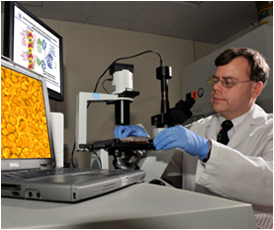Alumni, Broadcom MASTERS, Intel ISEF, Intel STS
Society Alumnus and Science Fair Judge Todd Rider Gives Advice
By Caitlin Jennings, Communications Specialst, Society for Science & the Public

When Todd Rider (Society Alumn: Science Talent Search 1986; International Science and Engineering Fair (ISEF) 1983-1986) made it to his first ISEF as a freshman, he had such a rewarding experience and was so impressed with the other projects, he rededicated his efforts to his research to make sure he could successfully compete and come back every year. “It was very influential to be able to conduct research at that young age and go from having an idea to doing literature research on something, doing experiments on it, writing it all up, and presenting it,” he says.
Years later, he’s still impressed with the projects he’s seen at the Massachusetts State Science Fair, where he has been judging for 15 years, and now with Broadcom MASTERS 2011, where he judged projects at a national level for the first time this Fall and really enjoyed it. “The caliber of the students is just so impressive,” Todd says, and he is also impressed by their enthusiasm for science.
What exactly makes a good science fair project though? “It’s very important, especially from my perspective as a judge, for it to be student led, student driven,” Todd says, adding that he is especially impressed with students who build their own tools. “I think that really shows much more initiative and helps the student gain a much better understanding of the science.”
Todd also emphasizes the importance of original research. “It doesn’t have to be earth shattering; you don’t have to really come up with the cure for cancer or something. But I think it’s really important for students to do something that’s at least somewhat different than what people have done before,” Todd says. “It might come out of their own interests, maybe they see some sci-fi movie that features something in it and they want to try to do a much simpler version of that, or maybe it’s a student who just loves gardening and wants to do something with plants.”
Todd knows firsthand that somewhat simple high school research can lead to big advances down the road. He recently invented the “CANARY” (Cellular Analysis and Notification of Antigen Risks and Yields), which serves as a canary in the coal mine for pathogens by detecting bacteria. It has many possible applications, Todd says. “Ultimately, you might imagine walking into a doctor’s office and, if you’re sick, you just cough on this thing and within a minute it would tell you exactly what you have.”
The CANARY spurred another project when he considered the different ways in which bacteria and viruses are treated. “I wanted something that would be as broad spectrum for viruses as antibiotics are for bacteria,” he says. That’s where DRACOs (Double-stranded RNA Activated Caspase Oligomerizers) came in, and early testing is promising.
Perhaps someday soon the CANARY and DRACOs will be staples in medicine. For now, it is interesting to wonder if they would have ever come to fruition had a high school freshman in 1983 not been so inspired by the ISEF projects he saw.
- Read about Todd’s work on CANARY and DRACO
- Ask Todd to give a presentation in your classroom
- Learn about the Society Alumni Program


